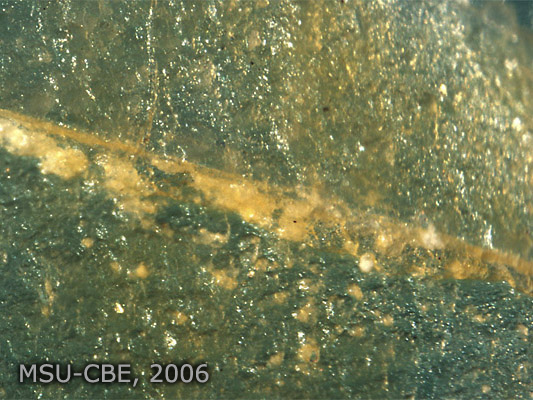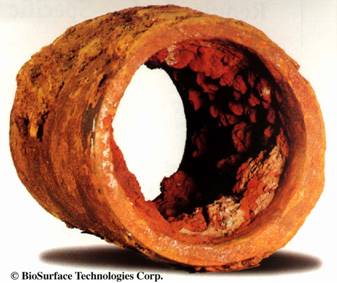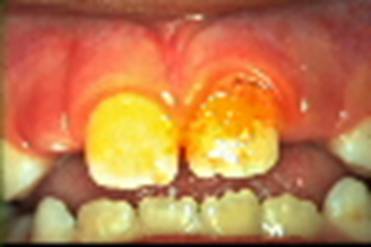Biofilms on Various Surfaces
As noted in the first page of this section, biofilms need four things in order to form and thrive:
- microorganisms
- moisture
- nutrients
- surfaces
The last requirement, surfaces, can be of many types, both liquid and solid. In this page we look at solid surfaces.
Biofilms on Solid Surfaces
The major factors in determining where biofilms form are: Location, Location and Location. Biofilms will form anywhere there is moisture and a surface with at least a minimal nutrient source. The possibilities are endless but fall into a number of well-studied categories. The following is a representative collection of biofilms, some naturally occurring and others showing human influence. They are sorted according to the type of liquid/surface interaction found in each case.
Biofilms on Solid Surfaces
The major factors in determining where biofilms form are: Location, Location and Location. Biofilms will form anywhere there is moisture and a surface with at least a minimal nutrient source. The possibilities are endless but fall into a number of well-studied categories. The following is a representative collection of biofilms, some naturally occurring and others showing human influence. They are sorted according to the type of liquid/surface interaction found in each case.
Desert Varnish

Desert Varnish is seen often in the deserts of the American southwest. It is a dark stain or coating covering rock surfaces that are intermittently exposed to moisture due to occasional rain, or from seeps. This moisture permits the growth of metal depositing microorganisms often organisms like Metallogenium and Pedomicrobium on and within the interstices of the rock. The typical composition of desert varnish consists of clay particles, and magnesium and Iron oxides that give the coating its dark color.

Shower Curtains

The “soap scum” commonly seen on vinyl shower curtains is revealed under microscopy to be a rich and vigorous biofilm. Of the many microorganisms found growing in these biofilms, there are a number of potential clinical importance. Of these perhaps the most significant are methicillin resistant Staphylococcus aureus, Legionella pneumophila and Mycobacterium avium complex. In one study of shower curtain microflora, a number of bacteria generally considered to cause “opportunistic infections” were found in large numbers. These included members of the genera Sphingomonas and Methylobacterium. Although probably harmless to most individuals, people with conditions that compromise their health may be at risk. These “compromising factors” might include those taking immune suppressants, people with open wounds or skin lesions, AIDS patients, young children and the elderly.

Paintings

Human works of art are especially susceptible to the actions of microorganisms. Bacteria, fungi and algae can unite in ways that are very destructive to art works including paintings, sculpture and architecture. Even such venerable treasures as the cave paintings of Lascaux are not immune to the effects of microbial growth and biodeterioration. Discovered in 1940, in the Dordogne region of France, the caves were very popular attractions in the years following WW II. An increase in carbon dioxide concentration and the tracking in of organic materials and soil from outside the caves added to the near constant illumination resulted in a massive growth of algae and cyanobacteria (the green disease), fungi and bacterial growth on the paintings. The 17,000 year-old paintings were created with mineral pigments mixed in animal fat and were prime targets for the degradative action of microbial enzymes. Authorities were so alarmed by the rapid decline of the paintings that they were closed to public viewing in 1963. Unfortunately, attempts by restoration experts to control microbial growth with disinfectants have in many cases hastened the deterioration of these world heritage treasures.
Submerged Solid Substrates

A common problem in industry and in water distribution is the effect biofilms have plugging pipes and in causing extensive corrosion of iron and mild steel pipes as shown here. Anaerobic zones formed at the biofilm metal substrate interface can provide conditions for the growth of sulfate reducing bacteria. These in turn can cause pitting with the pit itself becoming an anode and the metal surface surrounding the biofilm the cathode in what is essentially a microbiologically produced battery. The electro chemical effect can result in compromisation and eventual failure of the pipe.
Teeth

Perhaps the most readily recognized example of a biofilm is that which accumulates on our teeth and which if left undisturbed can result in loss of tooth enamel and the formation of dental caries (cavities). The mouth is the natural habitat of over 600 identified species of microorganisms and a large number of these engage in forming the gummy coating on our teeth called plaque. Within the incredibly complex biofilm produced on teeth are microorganisms such as Streptococcus mutans which ferment sugars to lactic acid which causes cavities. The biofilm producing consortia are also capable of causing gum disease and tooth loss. So Mom was right all along, limit your intake of sweets, brush often and don’t put off that dental appointment.
Microbe/microbe Interactions – Coaggregation
Lung Infections in Cystic Fibrosis Patients

Patients with the hereditary disease Cystic fibrosis are subject bacterial pneumonia particularly that caused by the organisms Pseudomonas aeruginosa. This bacterium produces large amounts of “slimy” polysaccharides that clog alveoli and greatly reduce Oxygen transport in the lungs. Fifty years ago, most children diagnosed with Cf died before their 6th birthday. Today with early diagnosis, decongestant treatment and aggressive antibiotic therapy, most patients can expect to live to be 30, 40 or even older


